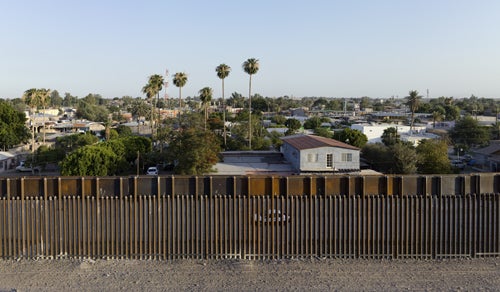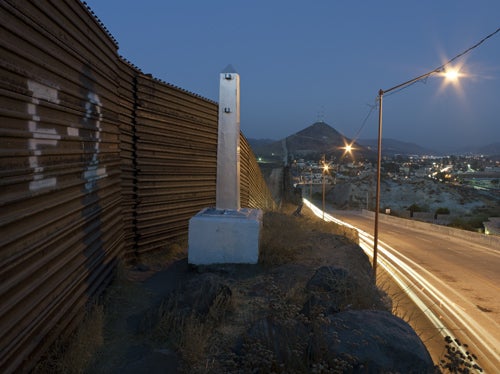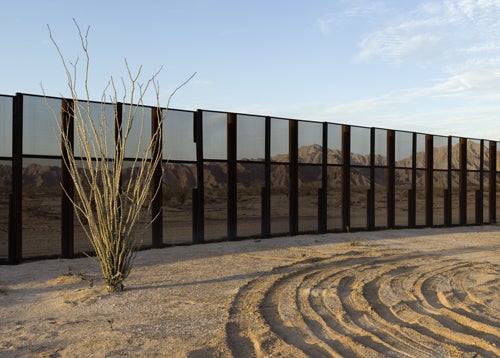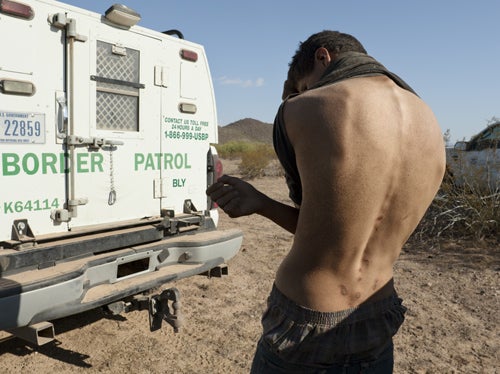master of fine arts '94
Photographs issues behind U.S.-Mexico border
UO alumnus (MFA '94) David J. Taylor, the 2008 recipient of a John Simon Guggenheim Memorial Foundation fellowship, is working the line. Specifically, working the U.S.-Mexico borderline. "Working the Line" also happens to be the title of his ongoing photography project that seeks to shed light on the complexities behind the U.S.-Mexico border.

Above: Bollard Fence, Los Algodones, Baja California. Photo by David Taylor.
After graduating from UO, Taylor taught photography and digital arts at the Oregon College of Arts and Crafts in Portland and Linfield College in McMinnville from 1996-1999. Since 1999, he has taught photography at New Mexico State University, where he was recently been promoted to associate professor. In 2008, Taylor was awarded just under $47,000 for a Guggenheim fellowship, permitting him to take a year off from teaching to pursue his ongoing U.S.-Mexico border project.
Taylor says that his time at UO laid the groundwork for his success. "Pursuing my MFA at UO enabled me to work with excellent faculty from a number of disciplines, both within and outside the art department," he says. "The mentorship of those faculty remains with me and I'm very grateful for their investment in my success."
His interest in his current body of work came naturally, he says.
"It's basically my back yard," says Taylor, referring to the border that lies just forty miles from his Las Cruces, New Mexico, home. "The issues at play with the border are part of our daily reality. I want my work to move away from a simplistic binary portrayal of the border as something 'illegal' and 'legal' and into a narrative that is more nuanced and complex."

Above: Border Monument No. 204, N 32º 29.045', W 114º 46.801'. Photo by David Taylor.
His photographs are intimate, from uncovering drug smuggling operations to documenting the arrests of illegal immigrants by U.S. Border Patrol agents. His confrontation with the issue adds a visual record of the complexities of the border through photography, video, and multimedia installations.
"It's a very stark reality," Taylor says. "Those who are desperate to cross the border are victims of an overarching problem. The lack of resources, infrastructure, inequality, and more that comes with these crossings – it can be challenging to be an observer to this."
Taylor's long-term project has afforded him direct contact with border patrol agents, migrants, drug smugglers, and others, giving him unusual access in an arena generally inaccessible to the public. From border checkpoints for vehicles to tracing migrant foot traffic in the most remote, rugged areas of the desert, Taylor has followed his subjects to far-flung locations in the American Southwest.
Since he began his work, the border patrol has doubled in size and has constructed 600-plus miles of fencing and surveillance, he says. These changes, he says, necessitate documentation and are part of a broader discussion of social, political, economic, and other forces at work.

Above: Border Monument 244, N 32º 34.624', W 116º 37.214'. Photo by David Taylor.
"I hope these images endure, that they have staying power in the minds of those who see them," says Taylor. "I want the photos to be a narrative of those who live the reality of the border and help shape our understanding of the nature of such issues."
Taylor has also been working on a photographic survey of the topography of southern New Mexico west of the Rio Grande River. A focal point includes the obelisks that have marked the landscape since the 1890s. He hopes the survey, which tracks the changes of the border over the past century and beyond, will open more conversations about the social justice issues behind the border. He is working with a publisher to produce a photography book about his border monuments project.
His most recent exhibitions include: El Paso Museum of Art in Texas (2011), James Kelly Contemporary in New Mexico (2011), Ballroom Marfa/Crowley Theater in Texas (2010), as well as numerous permanent and temporary exhibitions across the country, including the Aldrich Contemporary Art Museum in Connecticut (2009) and the Museum of Contemporary Photography and Columbia College in Chicago (2010). In recent years he has completed public commissions for a United States Border Patrol station in Van Horn, Texas, and for the federal courthouse in Las Cruces.
His images have also been featured in such publications as The New York Times and the Los Angeles Times and his most recent monograph, Working the Line, was published in 2010 by Radius Books.

Above: Drop-off Spot and Border Fence, Sonora. Photo by David Taylor.

Above left: Drop-off Spot and Border Fence, Sonora. Photo by David Taylor. Above right: Backpack Scars, Arizona. Photo by David Taylor.

Above: View into Nogales from the Border Fence (with camera tower), Arizona. Photo by David Taylor.

Above left: View into Nogales from the Border Fence (with camera tower), Arizona. Photo by David Taylor. Above right: David Taylor's photographs have been featured in such publications as The New York Times and the Los Angeles Times. His most recent monograph, Working the Line, was published in 2010 by Radius Books.
This story was originally published on May 16, 2012, as part of the 100 Stories collection, compiled to celebrate our 2014 centennial and recognize the achievements and contributions of our alumni worldwide. View the entire 100 Stories archive on the College of Design website.
